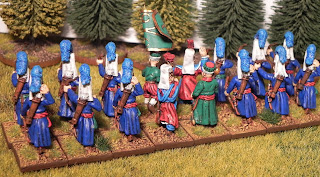After
one-and-a-half-month of silence I am here with my newest unit. I got
the figures in December however I was lazy to paint so the process
was really slow.
The
janissaries were the toughest soldiers of the Ottoman army. They were
well trained and disciplined infantrymen. The Turkish term „yeñiçeri”
means new corps. The creator of the unit was sultan Murad I. who
organized a personal bodyguard for himself from slaves in 1363. At
the beginning the number of the janissaries was only 1000, by the end
of the 15th century it increased to 8000 and after Süleyman the
Magnificent's death to ca. 40 000.
After
the end of the 14th century they were collected through the
„devşirme”
system. Within this, young Christian boys aged between 8 and 10 years
were selected by trained agents. The collecting areas of the system
were the vassal Christian states of the Ottoman Empire in the Balkans
like Bulgaria, Serbia, Albania, Greece and Bosnia. Orphans, only
sons, Jews or Gypsies were exempt and for example gathering children
from Hungary was not allowed. Then the selected boys moved to
Istanbul on foot where the very best of them were divided between
schools. The others who were not chosen were adopted by Muslim
Anatolian families. They were converted to Islam and the hard work on
the farms trained them for the military service. Later they went to
military schools and became ordinary military officers. The
youngsters who learned in the Enderûn
schools got a hard military training
and later they became janissaries. Only a few and the most talented
were placed in the palace school. These learned Islamic sciences,
mathematics, geography, Persian, Turkish and Arabic language,
history, law, administration and arts. They also got physical and
military training. The graduates of the school later could become
military commanders, statesmen, administrators, scientists and
teachers.
In conclusion, the goal of the devşirme system
was to select the elite of the elite. Some people see it as
kidnapping or enslaving the Christians however this was a great
chance to break out for the common boys. Sometimes even parents gave
intentionally their children to the devşirme to help their
children's living conditions and ground their career.
The most important weapon of the janissaries was
the bow. They were extremely trained archers and used the thumb ring
shooting technique. From the middle of the 15th
century more and more handguns were applied by them. Their primary
melee weapon was the Ottoman sabre, the kilij.
They also used halberds, axes and daggers. Janissaries wore uniforms,
which was a long-sleeved coat. The headgear was made from tubular
white felt which was called börk.
They lived in barracks in peacetime and were paid regular salaries.
Strict rules regulated their life in the barracks. The basic unit of
the janissaries was the orta
(battalion). Some of the officers bore titles related to food such as
aşçı başı
(chief cook) - the commander of the orta
and the çorbacı
(soup maker). The ocak
(janissary corps) was the part of the kapikülü
corps. They marched into battle on the encouraging music of their
military band - the mehterân. The
patron saint of the janissaries was Hacı Bektaş and the bektaşhi
dervish order closely linked to them.
In
battles, they usually filled in defensive roles. Often defensive
lines were applied to protect them from enemy cavalry like wooden
stakes linked with chains, ramparts and even wagon tabors. However,
during sieges, they could make rapid charges.
The
lines of the janissaries were able to stop the charges of the
European knights in many battles like at Nicopole 1396, Varna 1444,
Kosovo Polje 1448 and at Mohács in 1526.
The
janissaries played an important role in the Ottoman Empire. They made
up the base of the power of the sultan. Because they were foreigners
who had no interest in the politics they were very faithful to the
sultan. Nonetheless there were some janissary revolts during the
history of the Empire.
In
1826 when sultan Mahmud II wanted to modernize the Turkish army along
Western European lines they turned against him. The revolt was stroke
down, many of them were executed and the janissary corps were disbanded.
The
figures are from Assault Group Miniatures.












No comments:
Post a Comment